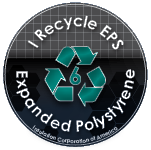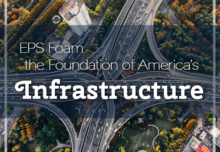EPS, ABC – we are becoming a language of acronyms and initials. What are EPS and ABC and how do they work efficiently together? EPS stands for expanded polystyrene, which is commonly but incorrectly referred to as Styrofoam™. (Styrofoam is actually a Dow trade name and is blue in color.) EPS used in block form for geotechnical applications is referred to as Geofoam. ABC, in this reference, stands for Accelerated Bridge Construction, which is defined by the Federal Highway Administration as “a paradigm shift in the project planning and procurement approach where the need to minimize the mobility impacts which occur due to onsite construction activities are elevated to a higher priority.” A simple translation of that would be, an effective approach to construction to reduce time and cost in building new bridges and replacing old ones.
How exactly do EPS Geofoam and ABC work together?
Bridge replacements are costly and impact the traveling public. Building a new bridge off site and virtually putting it in place saves time, money and improves safety for motorists. Large ABC projects have been studied and the advantages are paving the way for this method to become the standard in this industry.
Geofoam additionally contributes to this time saving building application. The applications of Geofoam in ABCs can vary from project to project. It can be used to reduce lateral loads, repair slope failures, minimize settlement at bridge abutments, and fill for approach embankments. All of which add the acceleration to the project’s completion.
According to two articles from the Federal Highway Administration (FHWA), the benefits of ABC and Geofoam are almost interchangeable.
In the first article, FHWA states –
ABC improves:
- Site Constructability
- Total Project delivery time
- Work-zone safety for the traveling public
ABC reduces:
- Traffic Impacts
- Onsite construction time
- Weather-related time delays
In the second article, FHWA reports from an EPS Geofoam case study from the Woodrow Wilson Bridge where hundreds of Geofoam blocks were used.
Benefits of Geofoam:
- Accelerates foundation construction, which reduces project schedules
- Saves money
- Requires limited labor for construction
- Exerts little to no lateral load on retaining structures
- Can be constructed easily in limited right-of-way areas and in adverse conditions.
Do we see the similarities?
Our nation has approximately 150,000 bridges that are in need of repair or replacement. Accelerating this process for our safety while decelerating overall costs and time are the reasons ABC is approved by DOTs across the country.
Two of the United States largest Geofoam projects are in Utah. Geofoam has been a major factor in success of UTA rail project, Frontlines. UTA committed to building 70 miles of rail in 7 years with completion in 2015. These projects benefit the residents with transportation options and decrease traffic congestion, which is a give-back to the environment. The following video gives an overview of these projects.
How can ICA help with your EPS, ABC and DOT needs? ICA, Insulation Company of America, is a woman owned manufacturer of expanded polystyrene servicing the northeastern United States.
Visit the following links to learn more about Geofoam:
The Syracuse University Geofoam Center
• • • • • • • • • • • • • • • • • • • • • • • • • • • • • • • • • • • • • • • • • • • • • • • • • • • • • • • • • • • • • • • • • • • • • • • • •
This article was posted on April 11, 2014, by Insulation Corporation of America (ICA) – a Women-Owned manufacturer of Geofoam and Expanded Polystyrene (EPS), which is commonly but mistakenly referred to as Styrofoam™. ICA is located in Allentown, PA and services the entire Mid-Atlantic Region from Virginia to Maine to Ohio.







